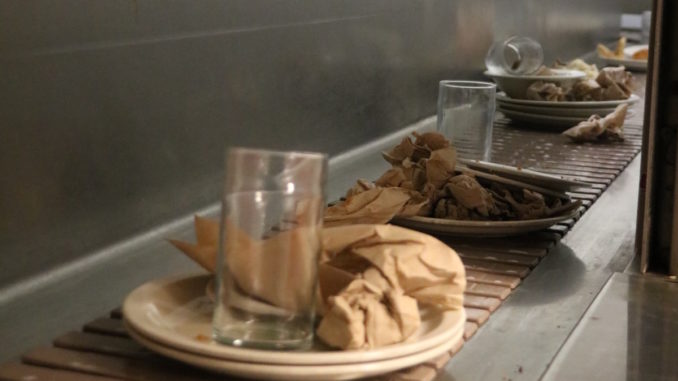
By next spring, the Truman State University Compost Project hopes to be able to sell its compost to maintain its equipment and fund the student interns working on the project.
Michael Seipel, agricultural science department chair and faculty adviser for the Compost Project, has applied for a sabbatical for the fall 2020 semester to focus on how to further improve the composting program.
Two farm workers pick up bins from the dining halls, the Student Union Building, Randolph Apartments and the Communiversity Garden and take it to the Truman State University Farm. There the compost is mixed with horse manure, sawdust and straw. An aerator mixes the material to introduce oxygen, and then the composting process begins. There is also a public bin by the Communiversity Garden where the public can drop off their household food composting. Food items like chopped veggies, leftover rice, compostable dining ware and napkins are all composted.
“The vast majority of what we get comes from dining halls,” Seipel said. “Each of the dining halls has a pulper in the kitchen, and so when students return trays to the tray return, napkins [and] food waste go into that pulper, and it basically chops the material up and spins it to remove as much of the water as possible and then that gets put into a bin and that bin gets picked up.”
Seipel said 142,000 pounds of waste were picked up from the dining halls during the 2018-19 school year, which is approximately equal to the weight of a space shuttle.
Ryle Hall feeds the largest number of students and has the most food waste as a result, Seipel said.
“A lot of times we are finding a lot of the volume [of food waste] comes from those partially eaten dishes at the end of the meal that cannot be saved,” Seipel said.
Stewart said that Sodexo only allows students to take the one entree at a time to control food waste. He said people tend to eat with their eyes and not their stomachs.
One of the tools utilized by the composting program is the pulper.
“What [the pulper] does as opposed to a garbage disposal is it grinds the food and separates the water waste, and then the water is recirculated and in turn, we are saving some water down the line,”Sodexo General Manager John Stewart said.
Stewart said Sodexo has a concern for food waste alongside the consumption issues and financial costs that come with it.
Sodexo has a 2025 goal to reduce its carbon footprint and to reduce energy and food waste.
“We do put forth great efforts when it comes to food waste,” Stewart said. “It is an initial cost we try to avoid to keep meal plans as low as they are.”
The Student Union Building does not have the same pulper and composting processes as the dining halls yet, Stewart said, but it does have compost buckets where Sodexo salvages food waste for compost. Sodexo plans to add more composting provisions when they do a remodel of the SUB in the future, Stewart said.
Until then, some food waste goes down the disposal but not much, Stewart said. Sodexo tries to utilize the tubs as much as they can, Stewart said.
Funds from the Environmental Sustainability Fee went to purchase a screener, Seipel said, which will allow the University Farm to take the finished compost and screen out any larger chunks of dirt or even things like silverware and plates that could end up in the food scraps. This results in a product that can be used in potting mixes or applied to gardens and lawns.
“The composting process is very important,” Seipel said. “It keeps the waste out of the landfill, but even more important is trying to reduce food waste to begin with. Just because we are composting doesn’t mean students shouldn’t care about the food they are wasting. There was still energy, labor, water that went into producing that food and we all need to be careful on our shopping [and consuming] habits.”
